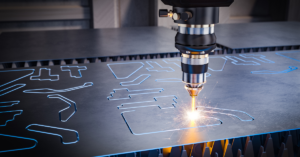
Laser and traditional methods each have their advantages and disadvantages impacting decision-making for different applications. In this blog, we’re going to take a closer look at these methods to understand them better.
Advantages of Laser Cutting
Laser cutting creates intricate designs with razor-sharp detail. It’s used with several materials including delicate fabrics, robust metals, and everything in between. This makes it a popular choice in manufacturing, automotive, and aerospace projects and industries.
Another advantage is Its phenomenal speed which allows for quicker project completion. This provides a competitive edge over traditional cutting methods when meeting tight deadlines. In fact, it has been said that “Few production methods can come close in processing speed to laser cutting. The ability to cut a 40 mm steel sheet using a 12 kW oxygen-assisted laser provides speeds some 10x faster than a bandsaw and 50–100 times faster than wire cutting” (Xometry, 2022). While the actual rate can vary depending on the material being cut, the thickness of the material, and the intricacy of the design, in general, laser cutting is known for its lightning speed.
Drawbacks of Laser Cutting
Despite its many advantages, laser cutting also comes with an initial cost hurdle that must be overcome. The upfront investments may deter smaller businesses with budget constraints, regardless of the precision and versatility this method offers.
Even though it’s capable of crafting intricate designs, it still faces limitations in effectively cutting thicker materials. That’s why projects involving thick materials may need to use traditional methods.
Advantages of Traditional Cutting
Traditional cutting methods use more affordable equipment such as:
- Scissors to cut fabric and paper
- Guillotine paper cutter to trim paper and cardstock
- Band saw to cut curves and irregular shapes in woodworking and metalworking projects
- Rotary cutter with a circular blade can be used for quilting and sewing
- Hacksaw with a fine-toothed blade to cut plastic pipes and rods offers more affordable equipment.
This makes it an attractive choice for budget-conscious businesses.
While laser cutting is versatile, traditional methods still excel with specific materials. Woodworking projects, for example, benefit from hands-on artistry preserving the authenticity of human craftsmanship. This approach is particularly valued in industries where items are hand-crafted rather than mass-produced.
Drawbacks of Traditional Cutting
Traditional cutting methods operate at a slower pace compared to laser cutting, negatively impacting project timelines.
While skilled craftsmen achieve remarkable accuracy, traditional methods may struggle to produce intricate designs, limiting their usefulness in certain applications.
Conclusion
Laser cutting and traditional methods each have their own strengths and weaknesses. The choice between the two depends on the specific needs of the project, including material type, design complexity, budget, and timeline. For more information reach out to EDCO Fabrication. We have cutting solutions tailored to your specific requirements.
Works Cited
Xometry, T. (2022). Advantages and disadvantages of laser cutting. Xometrys RSS. https://www.xometry.com/resources/sheet/laser-cutting-advantages/
